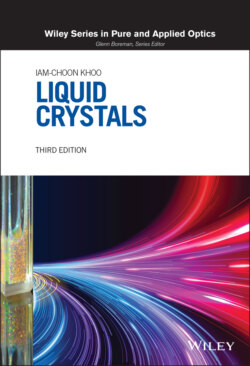Читать книгу Liquid Crystals - Iam-Choon Khoo - Страница 56
3.6.1. Field‐induced Reorientation Without Flow Coupling: Freedericksz Transition
ОглавлениеThe following example demonstrates how the viscosity coefficient γ1 comes into play in field‐induced reorientational effects. Consider pure twist deformation caused by an externally applied field on a planar sample as depicted in Figure 3.12. Let θ denote the angle of deformation. The director axis is thus given by = (cos θ, sin θ, 0). From this and the preceding equations, the free energy (Eq. 3.4) and elastic torque (Eq. 3.13) are, respectively,
(3.72a)
and
(3.72b)
Figure 3.12. Pure twist deformation induced by an external magnetic field H on a planar sample; there is no fluid motion.
The viscous torque is given by
(3.73)
The torque exerted by the external field (applied perpendicular to the initial director axis), from Eq. (3.29), becomes
(3.74)
Hence, the torque balance τ equation gives
(3.75a)
In the equilibrium situation, γ1dθ/dt = 0, and Eq. (3.75a) becomes
(3.75b)
An interesting result from this equation is the so‐called Freedericksz transition [3]. For an applied field strength less than a critical field HF, θ = 0. For H > HF, reorientation occurs. The expression for HF is given by
(3.76)
assuming that the reorientation obeys the hard‐boundary (strong anchoring) condition (i.e. θ = 0 at z = 0 and at z = d). For H just above HF, θ is given approximately by
(3.77a)
where
(3.77b)
For the case where H is abruptly reduced from its value above HF, to 0, Eq. (3.75a) becomes
(3.78)
Writing θ(z, t) = θ0 sin (πz/d) gives
(3.79)
that is,
(3.80)
where the relaxation time constant τ is given by
(3.81)
Most practical liquid crystal devices employ ac electric field. Accordingly, the Freedericksz transition field EF is given by simply replacing Δχ m with Δε; i.e. we have
(3.82a)
(3.82b)
For 5CB [20, 21], k ~ 10−11 N, Δε ~ 11 (ε|| ~ 16, ε⊥ ~ 5), ε0 = 8.85 × 10−12 F/m, Δσ/σ⊥ ~ 0.5, and VF ~ 1 V.
In Chapters 6 and 7, we discuss these field‐induced nematic director axis reorientations in detail in the context of electro‐optical switching and display applications.
